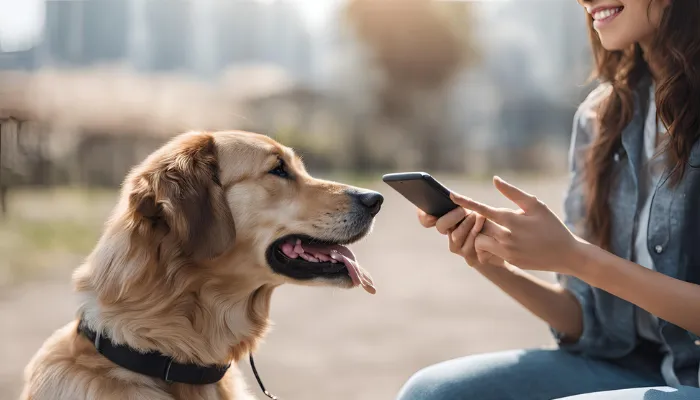What Is Sorry in Dog Language? Dogs express themselves through body movements, sounds, and actions rather than words. Understanding how they show remorse can help strengthen your bond with them. But can a dog translator help us better understand these signals?
Remember, whether a dog has destroyed your prized possessions or might have spilled something, dogs know how to ask for forgiveness. We will take a look at all the signs that indicate a dog is asking for forgiveness, and how best to react to them.

How Do Dogs Say Sorry?
What Is Sorry in Dog Language? A dog’s body language speaks multitudes and so does a dog owner. Although, dogs cannot verbally articulate “I’m sorry“, they use specific actions to showcase guilt or regret which stem from their ancestry and social group structures. Here are a few behaviors that depict a dog’s remorsefulness:
- Lowered Head and Avoiding Eye Contact:
- Indirect, lower body posture entails a dog is submissive, therefore, that dog posture showcases a sign of apology.
- Another respectful gesture is avoiding eye contact by looking down, which is a sign of submission.
- Tucked Tail:
- Carrying a tail in a lowered posture is negative canine body language which demonstrates remorse and submission.
- Which in turn indicates awareness of their wrongdoing and a desire to be forgiven.
- Ears Pinned Back:
- When an animal’s ears are laid back flat against the head, it is a sign of an anxious feeling or a guilty feeling.
- This trait can often be noted with dogs that have been given a reprimand.
- Pawing or Nuzzling:
- Some dogs may paw with one of their front legs or nuzzle his head against their owner to show they are sorry.
- This behavior indicates a form of submission with some pleading that forgiveness should be granted.
- Rolling Over or Exposing Belly:
- The canine reveals its torso is as a way of expressing submission and trust.
- This action is often performed alongside slow wagging of the tail.
Recognizing these signs strengthens your bond. What Is Sorry in Dog Language? It’s shown through body language like tucked tails and nuzzling!
Why Do Dogs Apologize?
Dogs live in packs, and as within any pack, relative peace should always be maintained. Apologetic behavior of dogs is often an effect of their owner’s body language, tone of voice, or prior experiences. Here is what dogs do and why they look like they feel sorry:
- Avoiding Conflict: As a matter of instinct, dogs use submissive postures to avoid any further confrontation.
- Seeking Reassurance: They depend on their owner’s approval for a sense of safety and comfort.
- Conditioned Response: Based on certain previous interactions, dogs will notice that some behavior, which once elicited a bad response, results in that type of behavior to be displayed as a sign of guilt.
Understanding why dogs appear to apologize helps us respond with patience and reinforce positive behavior effectively!
How to Respond When Your Dog Says Sorry?
When you see signs that your dog is apologizing, it is important for you to take some actions in order to maintain and improve positive behavior. So, what is sorry in dog language? Here is what you can do:
- Acknowledge Their Apology: Speak softly to your dog, so that they feel at ease.
- Avoid Harsh Punishments: Fear can be a result of harsh scolding, and that is not the goal. Instead, try using different techniques.
- Encourage Positive Behavior: Let them refocus on more appropriate tasks.
- Provide Comfort: Trust can be regained by kind words or gentle pats.
Your relationship with your dog can improve, and his actions, in return, can be superb if you embrace patience and positivity.
Common Misconceptions About Dog Apologies
Dogs tend to be expressive but they don’t feel guilt like humans do. Here are some myths busted:
- Dogs Apologize Out Of Guilt: They tend to be submissive rather than displaying true feelings of guilt.
- Guilty Face Means They Know They Were Wrong: This indicates something else. It shows that they are reacting to the owner’s body language and not their tone of voice.
- Dogs Remember Their Mistakes: They learn from each action, but unlike humans, dogs do not have the ability to reflect on their actions.
Getting to the core of these misunderstandings enable us to be more effective in our communication with our dogs and create stronger bonds built on trust!
Conclusion
Knowing What Is Sorry in Dog Language? assists in improving the bond between humans and dogs. When dogs want to show apology, they lower their head, tuck their tail, put out a paw or show some submissive body language.
Whenever such gestures are noticed, responding to them with suitable patience and encouragement helps in building a close and trusting bond with the pet. The next time your dog appears guilty, remember that they are desperately craving acceptance and forgiveness from you.
